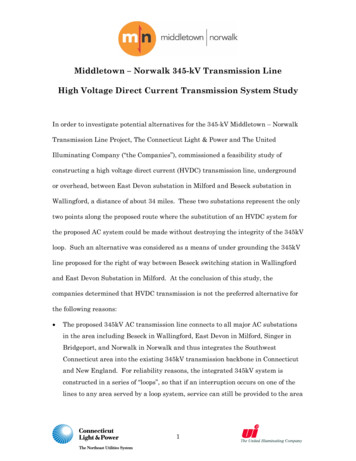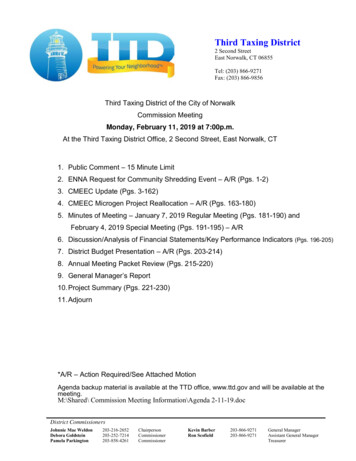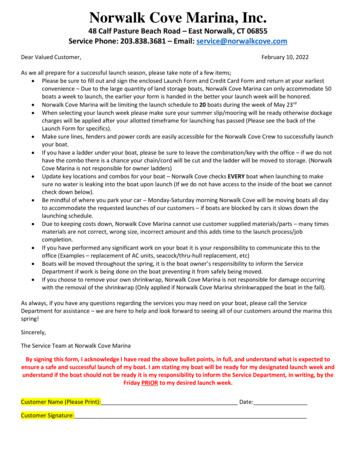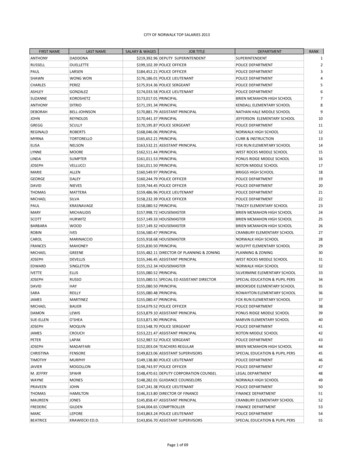
Transcription
NORWALK POWER ECONOMICIMPACT ANALYSISCITY OF NORWALK & MANRESA ASSOCIATIONFINDINGS & RECOMMENDATIONS REPORTPhoto Credit: Geoffrey Steadman12/14/18
Table of ContentsIntroduction.1Summary of Findings.3Section 1: Context and Reuse Planning.7Section 2: Site Characteristics & History.11Section 3: Remediation Analysis.19Section 4: Natural Resources.31Section 5: Economic Development Profile.37Section 6: Community Perspective.45Section 7: Development Constraints.53Section 8: Reuse Options.59Section 9: Remedial Strategies & Cost Estimate.77Section 10: Recommended Redevelopment Concepts.81Section 11: Implementation Plan.91Appendix.95
IntroductionManresa Island is comprised of two parcels that occupy approximately 144 acres of Norwalk’s shoreline. In1960, a power plant was commissioned on the southern parcel by Connecticut Light & Power. The plant begunoperations as a coal fired plant but was converted to oil in 1972. In 1999, the property was acquired by NRGEnergy. In 2012, the site was inundated with storm surge during Hurricane Sandy and was subsequentlyclosed in 2013.The Manresa Association was formed in 2013 as an advocacy group dedicated to ensuring that ManresaIsland is environmentally safe, provides open space and conservation habitat, and contributes to the physicalbeauty of Norwalk and the Long Island Sound coastline. The association is comprised of over 900 householdsand several local neighborhoods and clubs. In 2017 the Manresa Association and the City of Norwalkpartnered to conduct a study with the aims of identifying potential future uses of the property and assessingthe potential economic impact of those uses. The City and Association selected Fitzgerald & Halliday Inc.and subconsultants Tighe & Bond (remediation and engineering expertise) and Ninigret Partners (economicexpertise) to conduct the study.The study team has worked closely with the project steering committee which is comprised of representativesfrom the City of Norwalk (Redevelopment Agency, Planning Department, Economic Development, andvarious Commission Members) and the Manresa Association. The City, Manresa Association, and study teamhave conducted outreach with NRG Energy to solicit information and receive feedback on findings. NRG hasprovided access to the property and representatives from NRG attended a public workshop in support of thestudy.In May of 2017, Connecticut Senators Chris Murphy and Richard Blumenthal released a joint statementurging NRG to participate in the study and work towards a solution for the property that will mutually benefitall parties. This was followed by a statement released in June of 2018 by Senator Murphy, Blumenthal andCongressman Jim Himes supporting efforts to remediate, restore and revitalize Manresa Island.This report provides an overview of environmental and ecological conditions of the property, remediationefforts to date and planned and potential remediation approaches, regional market conditions that willinfluence potential reuse of the property, and recommended reuses of the site based upon those conditions.Norwalk Power Economic Impact Analysis-1-
This page left intentionally blank-2-Norwalk Power Economic Impact Analysis
Summary of FindingsBetween 2012 and 2016, over two hundred coal or former-coal fired power plants have been retired; mostof those are located on the east coast. Within New England alone, six power plants, including Manresa,have closed or been retired within the past several years. While there are examples of successful powerplant redevelopment projects, later generation power plants such as Manresa lack structures with historic orarchitectural value and are likely best suited for demolition.According to ISO New England, the New England energy grid is likely to have sufficient resources in the longterm to meet reserve requirements although the development of fast-start (commonly natural gas) units wouldimprove system performance. Massachusetts and Rhode Island have been identified as the most suitable areasfor new power plant siting although the Fairfield County area has also been identified as an area of high electricdemand. ISO also finds that New England has potential for expanding energy trade with neighboring regions.As such, Manresa Island’s transmission lines and substation are strategic current and future assets.The closure of power plants triggers a long process of reuse planning that involves multiple phases includingdecommissioning, remediation, and potential redevelopment. The average time from closure to plannedcompletion of redevelopment is 27 years. The most common approach by operators following to closing a siteis to take “no action” as there is no federal or state requirements to decommission or sell the facilities. Of theover 200 closed sites over the past several years, only 35 sites have been decommissioned. Conversions of plantsto natural gas is equally common, with about 30 natural gas conversion projects underway across the country.The Manresa site is comprised of two parcels. The southern parcel includes the power plant, substation andother supporting facilities. The northern parcel is largely constructed of fill material and coal ash. Becauseof this substrate, contamination and surrounding wetlands and estuary areas, this parcel is not feasible fordevelopment. The recommended remediation strategy for this parcel is to allow for a process of “naturalattenuation” rather than active remediation an approach that still requires approval by the ConnecticutDepartment of Energy and Environment.Photo Credit: Geoffrey SteadmanNorwalk Power Economic Impact AnalysisGiven the limitations of the northern parcel, the southern parcel is the focus of reuse concepts presentedwithin this report. A majority of this parcel is within the 100-year flood zone which is a constraint to, but notprohibitive of, development. Remediation of the site could cost between 11.8 and 26.8 million, depending onthe specific reuse of the site. Demolition of the power plant structures would likely cost between 5.7 millionand 9.9 million.-3-
Based on market trends and conditions, the residential market presents itself asthe most likely driver of reuse of the property. This does not, however, precludea targeted development either as a build to suit office situation or some otherunique development idea brought forth by a developer. Given the associatedcleanup costs, a fairly dense development model would be required to offsetthe land preparation costs. An open question is the potential for a high enddevelopment where density would be reduced because the price points wouldbe higher. The viability of this approach depends in part on how much ofthe plant infrastructure remains, what happens with areas of contamination,and storm surge/resiliency questions. Any significant volume of residentialor office development is likely to face opposition from local residents whohave expressed concerns about an increase of traffic on local roads and areconcerned about environmental and visual impacts of development.There are multiple constraints to the reuse of the site for the uses listedabove, with some uses such as high-density residential being subject to moreconstraints than uses such as a solar farm. These constraints include, but arenot limited to, the following:While the market appears to favor residential development, there are multiplereuse options that could more effectively leverage the sites assets including theharbor and navigation channel, electric substation, and land area and solarexposure. These options include the potential for the establishment of a marinaand boat storage yard, the development of a solar farm, and the on-site storageof energy. FHI explores six unique reuse concepts in this report. These concepts wereidentified as feasible for further study based upon the existing conditionsanalysis, community and stakeholder feedback, and guidance from the project’ssteering committee. These reuse concepts include: ConservationTear-down with passive open spaceMarinaLow density/high value housingMedium density housingHigh density housingSolar farmEducational Facility Cost of remediation: The cost of remediation varies significantly upon theproposed reuse.Flood and coastal zone: The flood and coastal zones add complexity topermitting, engineering, and increase cost to development in addition tolimited some uses.Site access: Site access is limited to a local residential roadway.Utility infrastructure: The site does not have sewer or natural gasinfrastructure. These facilities are available on Longshore Avenue, one-halfmile from the site.Electrical transmission: Three acres of the 33-acre southern parcel areoccupied by Eversource’s electrical substation which will remain in placeregardless of future use.Zoning: The existing is very restrictive and does not allow multi-familyresidential or commercial development.Fiscal impact: The existing power plant infrastructure is a significantcontributor to Norwalk’s tax roles, demolition of the plant or transfer ofownership could negatively impact the revenue generated by this property.Community preferences: The community has been outspoken about theirpreference for a passive reuse their opposition against intensive uses suchas high density rtProperty rvation LowLowHighYesHighNegativeLowHighPassiveopen Low teLowYesLowPositiveHighModerateHigh olar FarmLowLowModerateSpecialPermitModerateMay be subjectto ssment matrix of reuse options-4-Norwalk Power Economic Impact Analysis
Given these development constraints, FHI recommends the advancement ofa mixed-use development concept for the site. This will allow for a diversifiedstrategy that leverages the site’s unique assets and allows for a phaseddevelopment. This approach is summarized below:Northern Parcel: ConservationThe northern parcel is best suited for conservation with limited publicaccess.Southern Parcel: Redevelopment for Active UsesA number of redevelopment options are recommended for the SouthernParcel including the following: Marina: Includes 110 slips, a 6 acre boat storage yard, a marina facilitybuilding, a public boat launch, publicly accessible waterfront trails andpublic parking. Solar Farm: Includes a 4.9 MW solar array and a 0.5 acre battery energystorage site. Educational Facility: An educational institution or destination facilitythat leverages the coastal location and waterfront access. Residential Development: Moderate density residential development ofup to 74 single-family homes.Norwalk Power Economic Impact Analysis-5-
This page left intentionally blank-6-Norwalk Power Economic Impact Analysis
Section 1Context and Reuse Planning1. Context2. Reuse PlanningNorwalk Power Economic Impact Analysis-7-
1. ContextNationwide, a significant number of fossil fuel power plants have been closed(retired) or were in the process of being retired over the past several years.Between 2012 and 2016, over two hundred coal fired plants have been retired,most of those were located on the east coast. This wave of closures is due inpart to Environmental Protection Agency (EPA) provisions under the CleanAir Transport Rule for emissions of nitrous oxide and sulfur dioxide (in 2012and 2014, respectively); a new Air Toxics Rule (in 2014); a tightened ozonestandard (2014–2016); new power plant water discharge rules under the CleanWater Act (2014–2017); and a strengthening of the National Ambient AirQuality Standards for ozone and ozone precursors (2014–2017).Within New England, the Manresa Power Plant is one of six power plants thathave closed or initiated the retirement process over the past several years.Multiple other plants are at risk of closure. These power plants have beenretired due to the age and condition of the structure, lack of compliance withenvironmental regulations and competition from more economically viablesources of generation such as natural gas or renewable sources.Many of the plants that have been retired are in urban areas and have ahigh potential for redevelopment due to waterfront locations, surroundingland values, and proximity to infrastructure. A number of successful powerplant redevelopment projects, such as the South Street Power Station inProvidence, RI, have preserved plant structures that have significant historicand architectural value. Later generation power plants such as Manresa, lackstructures with historic or architectural value and are likely best suited fordemolition.Closed, retiring and at-risk generation in New EnglandEnergy Generation in New EnglandThe future use of Manresa Island will be affected by the energy demands of theregion and the viability of future energy generation at the island. The studyteam reviewed ISO New England’s 2015 Regional System Plan and 2030 PowerSystem Study for information relevant to energy generation needs in the region.[ISO New England (ISO) oversees the operation of New England’s bulk electricpower system and transmission lines, generated and transmitted by its memberutilities.]According to ISO, the Greater Connecticut, Southwest Connecticut, andNortheastern Massachusetts/Boston areas are likely to have sufficient resourcesReported Coal-fired generator retirements 2012-2016, Source: EIA-8-Norwalk Power Economic Impact Analysis
in the long term to meet their representative reserve requirements. Theplacement of fast-start, energy-efficient, and economical baseload resourcesin these areas would, however, improve system performance. These faststart units are typically provided by natural gas units. The use of natural gasand fast-start units in the ISO’s network will likely meet long-term needs foradditional operating reserves.ISO’s studies suggest that the most reliable and economic place for developingnew resources is the combined Eastern Massachusetts and Rhode Island areas.Fairfield County was not identified as a desirable area for new generation,although 405 megawatts of replacement capacity will be needed in Connecticutbased upon planned retirements across the region and transmission constraintsthat limit transmission to Connecticut.ISO’s 2030 study recognized that New England has potential for expandingenergy trade with neighboring regions. ISO also identified options forimporting additional power through expanded transmission interconnectionswith New York, confirming that Manresa Island’s transmission lines andsubstation are strategic current and future assets in the regional electricitynetwork.Areas of high electric demand and potential wind generationzones Source: ISO New England 2030 Power System StudyNew England energy generation profile, Source: ISO New EnglandNorwalk Power Economic Impact Analysis-9-
2. Reuse PlanningIn response to a significant number of power plant closures and retirements,the EPA has produced guidance on coal plant decommissioning, remediationand redevelopment. While the Manresa plant was an oil-powered plant at thetime of closure, it was a coal-fired plant for decades prior to its conversion tooil and therefore faces many of the decommissioning and remediation issuescommon to coal-fired plants.According to EPA, after a plant closes, the site may remain dormant forseveral years before progressing through decommissioning, remediation andredevelopment. The multiple phases leading to a reuse of a site include: Decommissioning: The decommissioning of a fossil fuel fired powerplant may overlap with remediation and redevelopment. Duringdecommissioning, electrical generating units are shut down and alloperating permits are terminated. Hazardous materials associated withboth the generation process and the buildings/structures are removed.Electrical generating equipment is cleaned and may be removed for use atother locations or sold as scrap. Some demolition of buildings/structuresmay be performed to facilitate cleaning or equipment removal. Powerplants with on-site coal ash ponds or solid waste landfills must followfederal and state permit requirements for closure of these facilities.Remediation: Remediation involves the investigation and cleanup ofhazardous materials to meet federal or state requirements. It also includesdefining site-specific needs for redevelopment. The property owner isresponsible for ensuring that the cleanup meets all regulatory requirementsand works closely with stakeholders, environmental consultants and stateenvironmental agencies to develop and execute the remediation plan.Typical Reuse Planning Process, Source: USEPATypical Post Retirement Options No Action: The no action decision is taken on the majority of closedpower plants nationwide. Owners are reluctant to act because ofcosts, risk, and the attitude that “we’re not in the real estate business.”Economic drivers are unknown until engineering and real estatestudies are performed. There are no federal or state requirements todecommission or sell these facilities. Owner-Controlled Decommissioning: In some cases, owners may notbe able to sell a site, and they may not want to give up a site that maybe useful for new generation or transmission. In these cases, they mayopt to decommission aging plants to reduce risk, monetize salvage andscrap, and prepare a site for future uses. This would reduce carryingcosts for taxes and security. Of approximately 200 announced closuressince 2000, about 35 sites have been decommissioned. As-Is Sale for Decommissioning and Redevelopment: Some ownersopt to sell closed power plants as-is, because these sites have significantredevelopment potential. Remediation costs can be included andrisks can be managed through the use of contract terms, escrows, andenvironmental insurance. Developers may be willing to assume the riskof decommissioning in exchange for a reduced purchase price. Retrofit Conversion to Natural Gas: Conversion from coal or oil tonatural gas can be the most economical solution, there are about 30 gasconversion projects under way across the country. Replacement with New Generation: Would include modernizing andreactivating former generation.Redevelopment: The redevelopment phase includes new construction onthe site, reuse, and environmental controls to protect the use of the sitefrom remaining contaminants.Identifying potential reuse options early in the process can inform cleanupdecisions and determine the appropriate level of work needed in each stage ofthe assessment, cleanup and redevelopment process.- 10 -Norwalk Power Economic Impact Analysis
Section 2Site Characteristics & History1. Location & Context2. History of the Island3. Landscape4. Zoning5. Infrastructure6. Visual ImpactNorwalk Power Economic Impact Analysis- 11 -
1. Location & ContextManresa Island is located in Norwalk Harbor, onLong Island Sound, in Norwalk Connecticut. Theisland’s location, accessible via Longshore Avenue,lies within close proximity to Cafe Pasture Beach,South Norwalk, and various marinas and residentialneighborhoods. The island, currently owned by theNorwalk Power, LLC a subsidiary of NRG, is home tothe Norwalk Power coal-fire power plant, which wasdecommissioned in June, 2013. The power plant wastaken out of service following Superstorm Sandy thatdevastated Connecticut’s shoreline in October 2012.The site consists of two parcels; a northern parcelwhich is an undeveloped wooded area that providesa buffer between the Manresa power plant andresidential neighborhoods and a southern parcelwhich is the former power plant site. This undevelopedarea is not preserved as open space. Threeneighborhoods lie adjacent to the Manresa peninsulaon its north end; Village Creek, Harbor Shores, andHarborview. The neighborhoods are predominantlysingle-family homes on small lots.ManresaIslandSouthNorwalkNorthern parcel consists of: 97.0 acres Dense wooded forest cover Wetlands (freshwater and intertidal) Area of historic fillingSouthern parcel consists of: 46.9 acres Power plant Oil tank farm Wastewater treatment plant and associated basins Subsurface cooling water structures Dock and harbor (inactive) Electric substationThe site falls inside the Coastal Area Managementzone, which makes it subject to Coastal AreaManagement review and application processes.Calf PastureBeach157City ofNorwalkI-95ManresaIslandLongIslandSoundManresa Island Location- 12 -Norwalk Power Economic Impact Analysis
2. HistoryManresa Island was known as Boutons Island as early as 1664 and then lateras Keyser Island until World War II. In the early 1900’s Father Terence Shealyopened a Jesuit retreat center on the island, known as “Mount Manresa”. Thename came from Manresa, a town in Spain where St. Ignatius Loyola, thefounder of the Jesuits, developed a method of spiritual retreats. In 1911, Shealymoved the retreat to Staten Island, but the Manresa name remained.In 1953, the Norwalk Zoning Commission approved Connecticut Lightand Power’s (CL&P) plan to develop the Manresa property into a coal-firedpower plant. In 1955, the Marvin Beach Association in East Norwalk triedunsuccessfully to stop the power plant project, which came to fruition and wasbuilt in the late 1950’s. CL&P commissioned the plant in 1960 and it burnedcoal between 1960 - 1972, when it was converted from coal to oil power.A major fuel oil spill in 1969 caused significant damage to Village Creek beachand the tidal flats between Hoyt’s Island and Wilson Point. In that same year,a transmission line was installed under Long Island Sound that connectedManresa Island to Long Island. In 1980 the facility filed as a TSD (Treatment,Storage, and Disposal of Hazardous Waste) Facility in response to the 1976Federal Resource Conservation & Recovery Act (RCRA) which governs thedisposal of solid and hazardous waste. That triggered the Corrective ActionProcess, a requirement under RCRA that facilities investigate and clean uphazardous releases into soil, ground water, surface water and air.In 1990 the Norwalk Common Council adopted the Harbor ManagementPlan. This document called out the wetlands around Manresa Island as “areasof concern”. This designation required regular review of oil spill controlprocedures at the Norwalk Power Plant. In 1997 Manresa was named one ofConnecticut’s “Filthy Five” by the CT Coalition for Clean Air.In 1999 NRG Energy purchased the plant from CL&P and operated the plant asan oil-fired power plant until 2013. In 2012 the Manresa property was almostcompletely underwater during Hurricane Sandy. As a result of this, the Plantwas closed in June 2013.Postcard of Manresa InstituteThe NorwalkNorwalk Common Council adoptsHurricane Sandy:Zoning Commissionthe Harbor Management Plan, planManresa property wasapproves coalcalled out the wetlands aroundalmost completelypower plant onManresa as “areas of concern”underwaterManresa IslandManresa was namedPower plant isone of Connecticut’sconverted from coal“Filthy Five” by the CTpower to oil powerCoalition for Clean 90Fuel oil spill causessignificant damage toVillage Creek beach andtidal flats; Transmissionline was installedThe Marvin BeachAssociation triedunsuccessfully tostop the power plantprojectFacility filed as a TSD(Treatment, Storage, andDisposal of HazardousWaste) Facility, triggersRCRA Corrective ActionProcess199720132012Plant closedNRG Energypurchased theplant from CL&PTimelineNorwalk Power Economic Impact Analysis- 13 -
Changing LandscapeManresa Island has grown in size since the early 20th century, largely due to fillmaterial being deposited on the site. The original fill material may have beensourced from excavation for the power plant as well as harbor dredging. CL&Pwas permitted to fill the area to the east of the Manresa Island Road, currentwooded area, on the Northern Parcel with coal ash and sluiced water generatedas a by-product of the coal-fired power plant operations. Coal storage andhandling occurred on the Southern Parcel. The following aerial images displaythe changing landscape of Manresa Island.Expansionto east1951 Aerial PhotographSignificantexpansion tonortheastHarborPower plantCoal storage1934 Aerial Photograph- 14 -Original “dry land” area1965 Aerial PhotographNorwalk Power Economic Impact Analysis
Furtherexpansionto northExpansionto northWastewaterimpoundmentTransmissionlines to LongIsland1970 Aerial PhotographFuel tanks1985 Aerial PhotographEmergence oftree canopySmall pondsfilledDetention basinfilled and newbasin to south1991 Aerial PhotographNorwalk Power Economic Impact AnalysisDetention basinsabandoned2016 Aerial Photograph- 15 -
3. Utility InfrastructureManresa Island is served by a robust utility infrastructure that includessewer, municipal water, electricity, natural gas, and communications. Thisinfrastructure has capacity to accommodate development on the island; furtherassessment is required to determine the amount of development that existinginfrastructure could support.SewerCity of Norwalk sewer infrastructure is available immediately north of the site,but there is no current service to the site. Septic discharges are directed to anexisting septic leach field located within the southwest corner of the site.Additional development could require either connection to the City of NorwalkSewer System or construction of additional on-site septic systems. If new septicsystem is installed, excavated soils will require proper handling and couldrequire possible off-site disposal at an approved facility.WaterDrinking water is supplied by the South Norwalk Electric and Power Companywhich has water mains along Longshore Avenue.ElectricityThree phase electrical service is provided by Eversource Energy. Transmissionis provided to the site from Longshore Avenue.GasNatural Gas service is available on Longshore Avenue and is providedby Yankee Gas. The Kinder Morgan, Inc. (Tennessee Gas Pipeline) gastransmission line is located approximately five miles north of the site.CommunicationsTelephone/internet services are present on Longshore Avenue and are providedby Frontier Communications.NSewer service limits: Sewer gravity mains shown in red above- 16 -Norwalk Power Economic Impact Analysis
4. ZoningThe Manresa Island power plant property is zoned as “B Residence”. The intentof this zone is for single-family dwellings and other compatible uses. Underthe B Residence zoning classification, any non-residential or institutional usewould require rezoning of the parcel. The former utility use was permitted as aspecial permit use.Allowable uses in the B Residence zone include: Single-family detached dwelling unitsParks and playgroundsFarms, gardens and nurseries on parcels 12,500 square feet or moreUses allowed in this zone by special permit include: Public museumsPlaces of worshipSchools, public and private colleges and universitiesPublic UtilitiesHalfway houses (maximum of ten persons allowed)Youth day campsConvalescent or nursing homesPlanned residential developmentB Residence site requirementsAccessory uses allowed in this zone include: Home officeAccessory apartmentsLodging or rooming (up to two paying guests)Family day-careGreenhousesFarmers markets allowed as accessory use in public parks five or more inacres in sizeDevelopment of the power plant site with anything more intensive than singlefamily homes would require rezoning of the site from the current B Residencezone to a commercial, mixed use, or high density residential zone.Norwalk Power Economic Impact Analysis- 17 -
5. Visual ImpactThe Manresa power plant building and smoke stack have a considerable visual impacton the surrounding landscape. An analysis of the area conducted by the study teamrevealed that there are approximately 300 properties that have a view of the power plantbuilding and/or smokestack. Other features on the property such as the substation arefar less visible.The total assessed value of these visually impacted properties is 467.8 million and theseproperties generate approximately 11.9 million in property tax revenue per year.A. View from Calf Pasture BeachABB. View from Outer RoadCN- 18 -C. View from Bell IslandNorwalk Power Economic Impact Analysis
Section 3Remediation Analysis1. Environmental Conditions2. Remediation Standards3. Site Investigation and Assessment4. Areas of Environmental Concern (AOCs)5. Remedial StrategyNorwalk Power Economic Impact Analysis- 19 -
1. Environmental ConditionsThe Manresa site is comprised of two parcels (see map at right).The Northern Parcel is undeveloped with an overgrown, woodedarea and contains tidal and freshwater wetlands. An access road,Manresa Island Road, is oriented north-south and connects theNorthern Parcel and Southern Parcel with Longshore Avenue.The area to the west of the Power Plant Access road was subject tosignificant historical filling with coal ash by-product material fromthe coal-fired and oil-fired power plant on the Southern Par
Norwalk Power Economic Impact Analysis - 1 - Introduction Manresa Island is comprised of two parcels that occupy approximately 144 acres of Norwalk's shoreline. In 1960, a power plant was commissioned on the southern parcel by Connecticut Light & Power. The plant begun operations as a coal fired plant but was converted to oil in 1972.










